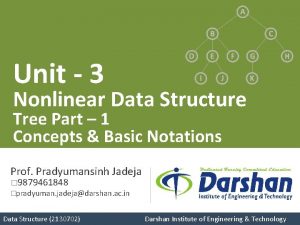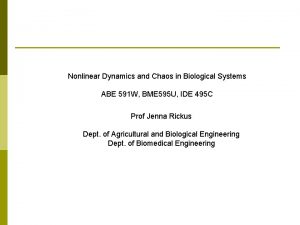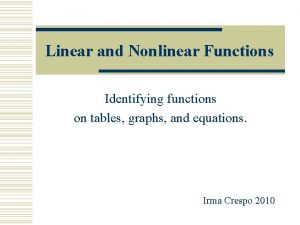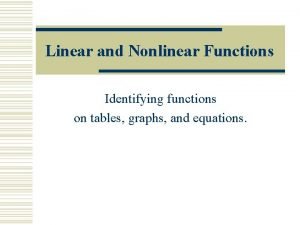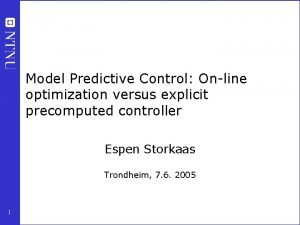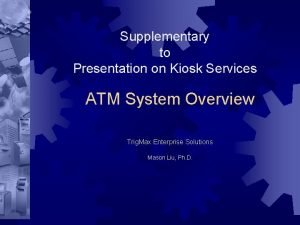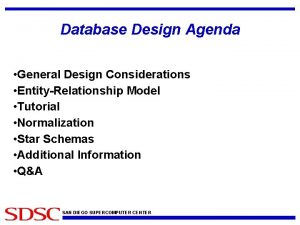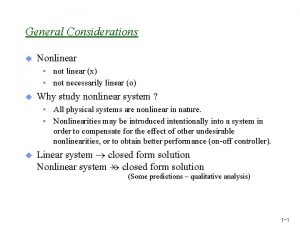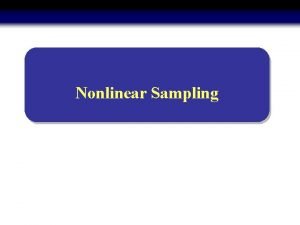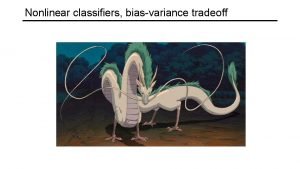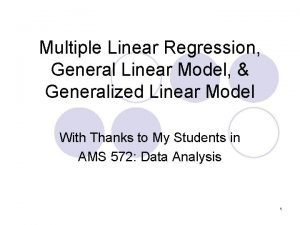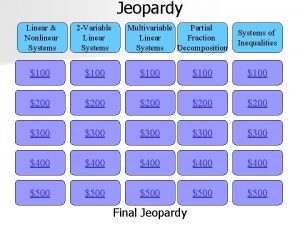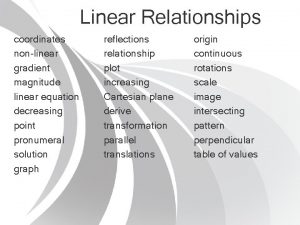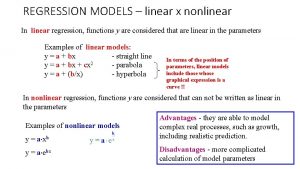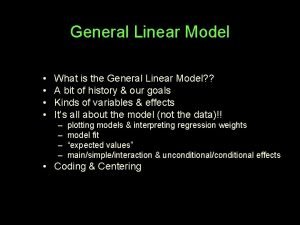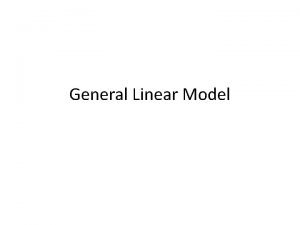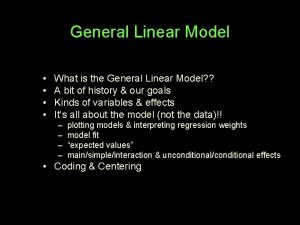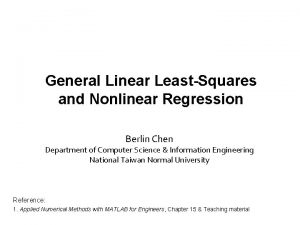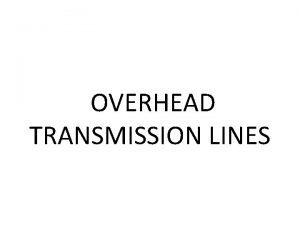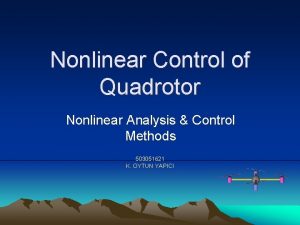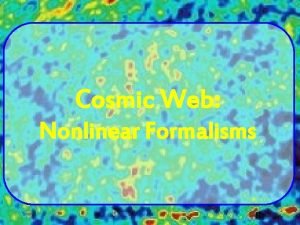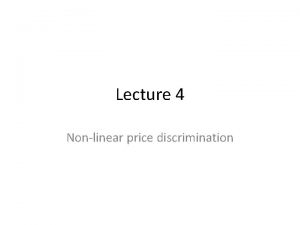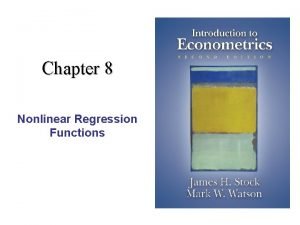General Considerations u Nonlinear not linear x not




























- Slides: 28

General Considerations u Nonlinear • not linear (x) • not necessarily linear (o) u Why study nonlinear system ? • All physical systems are nonlinear in nature. • Nonlinearities may be introduced intentionally into a system in order to compensate for the effect of other undesirable nonlinearities, or to obtain better performance (on-off controller). u Linear system closed form solution Nonlinear system X closed form solution (Some predictions – qualitative analysis) 1 -1

1. Phenomena of Nonlinear Dynamics u Linear vs. Nonlinear Input Output System state, Definitions : Linear : when the superposition holds Nonlinear : otherwise 1 -2

Stability & Output of systems • Stability depends on the system’s parameter (linear) • Stability depends on the initial conditions, input signals as well as the system parameters (nonlinear). • Output of a linear system has the same frequency as the input although its amplitude and phase may differ. • Output of a nonlinear system usually contains additional frequency components and may, in fact, not contain the input frequency. 1 -3

Superposition * Superposition Sys. = Sys. Is (1) linear ? + So is it linear? No, under zero initial conditions only. 1 -4

Linearity What is the linearity when ? + A mnemonic rule: All functions in RHS of a differential equation are linear. System is linear atleast at zero input or zero initial condition Ex: 1 -5

Time invariant vs. Time varying u Time invariant vs. Time varying • System (1) is time invariant parameters are constant - Linear time varying system • System (2) is time invariant no function has t as its argument. - Nonlinear time varying system 1 -6

Autonomous & Non - Autonomous • Time invariant system are called autonomous and time varying are called non - autonomous. In this course, ‘autonomous’ is reserved for systems with no external input, i. e. , Ex: • Thus autonomous are time invariant systems with no external input. This course will address nonlinear system, both time invariant and time varying, but mostly autonomous. 1 -7

Equilibrium Point u Equilibrium Point • We start with an autonomous system. Definition: is an equilibrium point (or a steady state, or a singular point) If det(A) 0, (1)has a unique equilibrium point, (Linear System). Nonlinear system ? × × × multiple equilibrium points 1 -8

Linear Autonomous Systems u What can a linear autonomous system do? where For 1 -dim sys. For 2 -dim sys. 1 -9

Linear Autonomous Systems (Contd. ) 1 -10

Solution of Linear systems • For linear sys, the following facts are true u Solution always exists locally. u Solution always exists globally. u Solution is unique each initial condition produces a different trajectory. u Solution is continuously dependent on initial conditions for every finite t, u Equilibrium point is unique (when det A 0). 1 -11

Periodic Solution • If there is one periodic solution, there is an infinite set of periodic solutions. (There is no isolated closed solution. ) Ex: ( many periodic solutions, w. r. t. I. C. ) 1 -12

Non - linear Autonomous System u What can a nonlinear autonomous system do ? Basically everything. • A solution may not exist, even locally. Here the solution is chattering, because function satisfying the equation exists. Therefore, no differential 1 -13

Solutions • Solution may not exist globally. Assume finite escape time (= : linear system) • Solution may not be unique. 1 -14

Equilibrium point • Equilibrium point doesn’t have to be unique. Ex: 1 -15

Periodic Solutions • Nonlinear system may have isolated closed (periodic) solutions. Ex: 1 -16

Isolated closed solution ( only one periodic solution. ) Isolated attractive periodic solution • Chaotic regimes non periodic, bounded behavior Ex: ( lightly damped structure with large elastic deflections ) 1 -17

2. Second Order Systems u Isoclines called “vector field” Set of all trajectories on plane Phase portrait 1 -18

Isocline(contd. ) Curve c is called an isocline: when a trajectory intersect the isocline, it has slope c, connecting isoclines, we can obtain a solution. Ex: 1 -19

Linearization u Linearization A nonlinear system can be represented as a bunch of linear systems - each valid in a small neighborhood of using linearization. Specifically, assume that is continuously, differentiable, Take one of the equilibrium, say Introduce, where =0 1 -20

Linearization(contd. ) Consider a sufficiently small ball The linearization of at around is defined by Ex: 1 -21

Linearization(contd. ) Then the two linearizations are 1 -22

Singular Points u Nature of singular points (a) 1 -23

Phase Portraits 1 -24

Phase Portraits(contd. ) (b) 1 -25

Phase Portraits(contd. ) (c) Let stable focus unstable focus center 1 -26

Nonlinear system u Nonlinear system Assume that the nature of this singular point in the linear system is What is the nature of the singular point in the nonlinear system ? Ans) Same, except for center. Center for the linear system doesn’t mean center in the nonlinear system. Equilibrium of a nonlinear system such that the linearization has no eigenvalues on the imaginary axis is called hyperbolic. Thus, for hyperbolic equilibria, the nature is the same as the linearization. 1 -27

Nonlinear system(contd. ) Ex: 1 -28
 What are the general considerations in machine design
What are the general considerations in machine design Linear and nonlinear data structure
Linear and nonlinear data structure Linear editing vs non linear editing
Linear editing vs non linear editing Linear and nonlinear data structure
Linear and nonlinear data structure Another word for symbol
Another word for symbol Contoh gaya berpikir linear dan nonlinear
Contoh gaya berpikir linear dan nonlinear Non liner plot
Non liner plot Non linear pharmacokinetics definition
Non linear pharmacokinetics definition Linear or nonlinear
Linear or nonlinear Contoh gaya berpikir linear dan nonlinear
Contoh gaya berpikir linear dan nonlinear Linear vs nonlinear pipelining
Linear vs nonlinear pipelining Linear or non linear
Linear or non linear Linear and nonlinear tables worksheet
Linear and nonlinear tables worksheet Nonlinear function table
Nonlinear function table Non linear multimedia example
Non linear multimedia example What is a nonlinear relationship
What is a nonlinear relationship Difference between linear and nonlinear spatial filters
Difference between linear and nonlinear spatial filters Differences between linear and nonlinear equations
Differences between linear and nonlinear equations Contoh fungsi non linear
Contoh fungsi non linear Nonlinear text example
Nonlinear text example Csc253 interactive multimedia
Csc253 interactive multimedia Linear or nonlinear
Linear or nonlinear Linear and nonlinear equations worksheet
Linear and nonlinear equations worksheet Tax considerations for setting up a new business
Tax considerations for setting up a new business Atm kiosk solution
Atm kiosk solution Three considerations of societal marketing concept
Three considerations of societal marketing concept Mechanical design of transmission line
Mechanical design of transmission line Database design considerations
Database design considerations Psychomotor considerations language acquisition
Psychomotor considerations language acquisition

